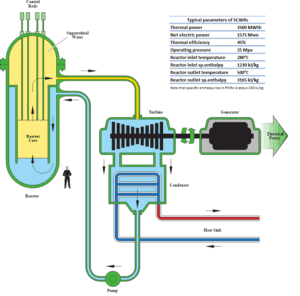Advantages and Challenges of SCWRs
 As can be inferred from its name, the SCWR’s key feature is the use of water beyond the thermodynamic critical point (TCR = 374 °C; pCR = 22.1 MPa) as primary coolant. SCWR designs have unique features that offer many advantages compared to current light water reactors (LWRs).
As can be inferred from its name, the SCWR’s key feature is the use of water beyond the thermodynamic critical point (TCR = 374 °C; pCR = 22.1 MPa) as primary coolant. SCWR designs have unique features that offer many advantages compared to current light water reactors (LWRs).
- High thermal efficiency. Since SCWRs supply supercritical steam at pressures and temperatures, that are much higher than in conventional LWRs, they will reach higher thermodynamic efficiency of the power plant (~45 % vs. ~33 % for current LWRs).
- Lower coolant mass flow rate. The reactor coolant flow rate of SCWR is much smaller than that of BWR and PWR because the enthalpy rise in the core is much larger, which results in low capacity components of the primary system. Thus, the coolant pumps, pipes and other supporting equipment become smaller. Moreover, the only pumps driving the coolant under normal operating conditions are the feed water pumps and the condensate extraction pumps.
- The higher steam enthalpy allows to decrease the size of the turbine system and thus to lower the capital costs of the conventional island.
- Smaller coolant inventory. The coolant inventory is smaller which reduces the size of the containment with pressure suppression pools.
- Since supercritical water does not undergo a phase change and it exists in a single thermodynamic phase, the boiling crisis (i.e. departure from nucleate boiling – DNB or dry out) cannot occur.
- With a direct cycle of supercritical coolant, components like steam dryers, separators and steam generators are omitted entirely, reducing the number of major components and eliminating their associated costs.
- Many of the components (e.g. turbine) are readily developed and available from supercritical fossil fired power plants.
The combination of advanced water-cooled reactor technology and advanced supercritical fossil technology is expected to result in a reactor concept that can be used to generate base-load electricity very economically and efficiently. This feature also makes the SCWR a very attractive concept for utilities, especially those that have experience with both water-cooled reactors and supercritical fossil plants.
On the other hand numerous challenges must be solved before the first power plants of this type can be built:
- The cladding materials have to withstand higher temperatures (600-650°C in normal operating conditions) than in today’s LWRs.
- The heat transfer phenomena from cladding surface into supercritical fluid must be understood thoroughly. Especially in case of within transients with depressurization from supercritical to subcritical conditions.
- Due to the smaller coolant inventory, the dry out of the core progresses faster in case of a loss of coolant accident (LOCA).
We hope, this article, Advantage and Challenge of SCWRs, helps you. If so, give us a like in the sidebar. Main purpose of this website is to help the public to learn some interesting and important information about thermal engineering.